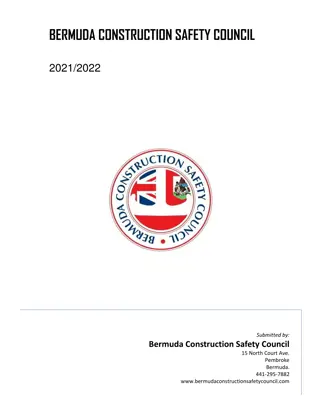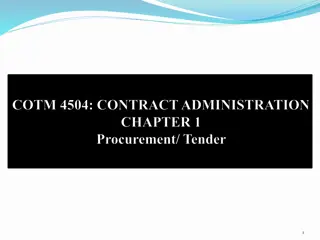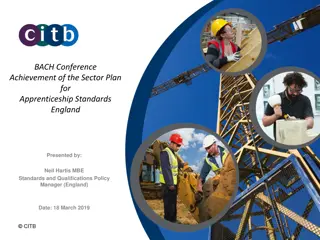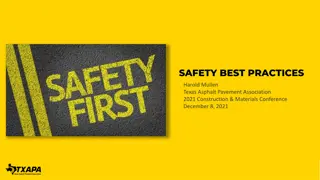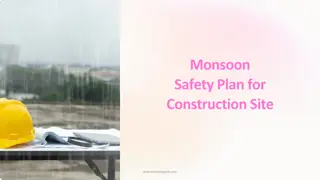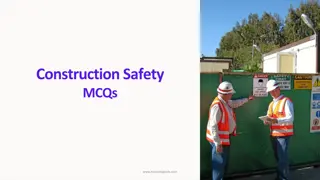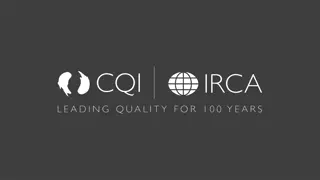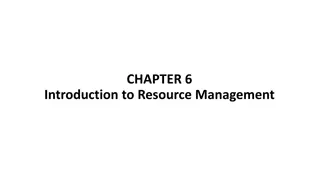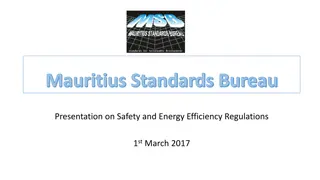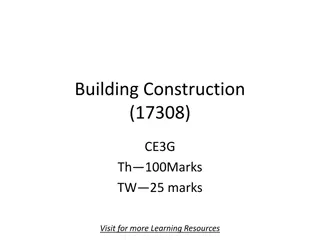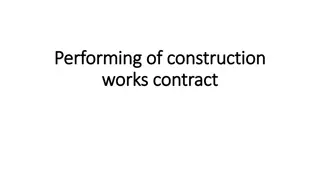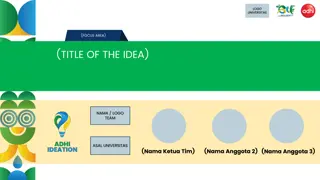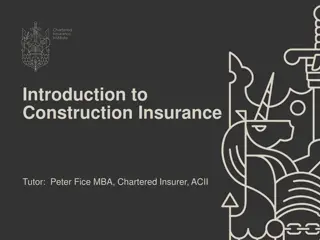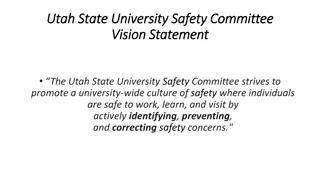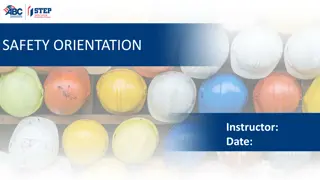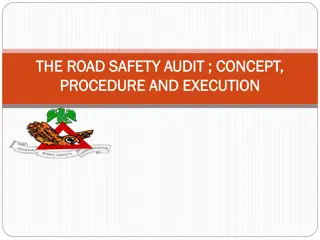Enhancing Safety and Efficiency in Scaffolding Practices for Construction Industry
Scaffolding plays a crucial role in construction work, and ensuring safety is paramount. With the booming construction industry, the need for improved scaffolding systems is evident. By adopting advanced technology and best practices, we can enhance safety, efficiency, and overall standards in the industry.
Download Presentation

Please find below an Image/Link to download the presentation.
The content on the website is provided AS IS for your information and personal use only. It may not be sold, licensed, or shared on other websites without obtaining consent from the author. Download presentation by click this link. If you encounter any issues during the download, it is possible that the publisher has removed the file from their server.
E N D
Presentation Transcript
DWAIPAYAN BHADRA, Sc E EROL, Kolkata Discipline Civil Engineering
Objective of the Project To study the usefulness of the standard in the present construction industry and bridging thegapwith the requirement of industry. The review of the standard for necessity of issuance of amendment or revision or withdrawal and replacement by a new standard, keeping in practices in the construction field for greater acceptabilityof the standard. view the current
BACKGROUND Scaffolding is a temporary structure used to support a work crew and materials to aid in the construction, maintenance and repairof buildings, bridges and all other man made structures at heights above the ground. Safety issues are the prime concern for the scaffolding.
BACKGROUND In the present scenario, when there is a boom in construction industry and high rise construction is going on everywhere use of scaffolds are getting tremendous popularity as these are easy to erect and can be dismantled immediately after work. The safety aspect of scaffolding along with cost wise economical aspect is essential for both manufacture and users of the material in current scenario.
BACKGROUND Safety is long regarded as one of the major concerns in local construction sites. Construction industry vulnerable to accidents. One way of dealing with the safety issues on site is to provide innovative technological solutions to problems. In order to reduce the high accident toll of scaffolding, the scaffolding system shall be improved by adopting advanced technology to raise the level of safety by means of strengthening improving the design. is one of the most the materials and
BACKGROUND Following conclusions may be drawn : Scaffolding can play a significant role in building repair works, safety of the Labours and materials in construction. Scaffolding can be easily erected with less energy and less effort. In recent trends, metal scaffolds are widely used in comparison to bamboo scaffolds due to its durability and safety. Various special scaffolding is beneficial for reducing accidents on large construction sites. Various scaffoldings are very helpful, for small as well as large construction projects which should be selected by considering financial level of project. Adoption of best International practices in the industry along with incorporation of the same in the standard for making the standard contemporary. Creation of general awareness among the users and manufacturers for use of best methods.
BACKGROUND For safety and health point of view, standard and codes should manufacturers and users after incorporation of good practices and safety aspects in the standard to make it user friendly and help in minimizing hazards. So it is high time BIS addresses the issue which will benefit the industry and generate revenue for BIS through BIS Conformity assessment scheme. be used by both
IS 2750:1964 Specification for Steel Scaffolding Scope requirements for materials, fabrication and performance of steel scaffoldings constructed with tubes, fittings frames, suitable for use in normal building construction work. 1.2 It does not include suspended or slung scaffoldings, 1.3 Scaffoldings constructed with material other than steel are also not covered in this standard. - This standard lays down the and/or prefabricated
IS 2750: 1964 The standard is around sixty years and the date of last amendment is more than 40 years old. Although scaffolding is used regularly by both in small and large projects the standard has not been revised. It was felt there is a need for review of the standard to incorporate current practices.
METHODOLOGY Carry out only feasibility study and submit report based on desktop analysis and review of Indian Standard a) Access International Regulations / Technical Journal & Papers from Industry/Association and International Journals etc. b) Interaction with Industry c) Interaction with Manufacturers d) Interaction with the organized and unorganized user including traders who are into construction industry. Standards/Technical
Methodology Due interaction Manufacturers However interacted with local engineers to know about the latest trends and practices in the industry. However International Standards and various documents pertaining to the subject was accessed for reference and study purpose. The same has been studied for review of the Indian Standards to the Covid could & 19 pandemic be much with not Industry made associations.
IS 2750: 1964 On review of the standard the following was observed: Restructuring the standard is required as per current specification standards The material specification of the components needs to be reviewed as there has been change in grade and specification including incorporation of new materials since its last amendment. Introduction of new varieties like system/ modular scaffolding for special works. The basic prefabricated frame is only covered in this standard Review the Design criteria as it is very generic in nature.
IS 2750: 1964 Further from interaction with industry it was understood: This item is repeatedly used and reused in the construction field without any sort of Expiry Date No specific guideline to identify or stipulate the life of the material regarding its repeated use. Further any type of Load Testing/Evaluation of results available to check the stability of the system Any Intermediate Checks Proper maintenance guidelines including checks and measures before reuse.
WORK DONE STUDY OF EXISTING LITERATURE SAFETY CODES RELATED TO ENABLING WORKS (SCAFFOLDING) Indian Standards IS 3696 : Part 1 : 1987 Safety code of scaffolds and ladders: Part 1 Scaffolds IS 4014 : Part 1 : 1967 Code of practice for steel tubular scaffolding: Part 1 Definitions and Materials IS 4014 : Part 2 : 2013 Steel tubular scaffolding - Code of practice: Part 2 safety provisions for scaffolding (First Revision)
WORK DONE Technical Documents A Guide to Scaffold Use in the Construction Industry (OSHA 3150 2002 (Revised) U.S. Department of Labor) BS-EN-12811-1-British-Standard-Scaffolding- Performance Requirement BS-EN-12811-2-British-Standard-Scaffolding- Material Requirement BS-EN-12811-3-British-Standard-Scaffolding-Load Test-Requirement BS EN 39:2001 - Loose steel tubes for tube and coupler scaffolds Technical delivery conditions BS 1139 Metal Scaffolding (Relevant Parts)
WORK DONE Technical Documents Australian/New Zealand Standard- AS/NZS - 1576.1:2010 - Scaffolding - Part 1: General requirements CODE OF PRACTICE FOR METAL SCAFFOLDING SAFETY (Labour Dept Govt of Hong Kong) Scaffolding Code of Practice 2009 (Queensland Government Gazette) BS EN 74-1:2005 - Couplers, spigot pins and baseplates for use in falsework and scaffolds NATIONAL ACCESS & SCAFFOLDING CONFEDERATION, UK (Technical Documents)
STUDY OF THE INTERNATIONAL DOCUMENTS On study of the International Standards the following is observed which is absent in the existing standard: Detailed methodology of structural and general design for scaffolds have been given Guidelines for Erection, dismantlement, movement, and modification of scaffolding Load Testing requirements and Evaluation of results of scaffold systems Inspection and maintenance procedures
The Building and Other Construction Workers' (Regulation of Employment and Conditions of Service) Central Rules, 1998 Review of the existing standards under scaffolding to see if there is any deviation with the current regulations To see if there is any additional requirement to be incorporated based on this regulation There is a requirement in the Rules that all metal scaffolds used in building or other construction work conform to the relevant national standards. However no BIS licenses
Action plan for completing the project The Way Forward Review of the standard vis a vis the other international standards and journals Introduction of a checklist to review the scaffolding system which is now used in many places. To distribute the same to the stake holders for getting a feed back.
Action plan for completing the project The Way Forward In the organized construction sector in most of the cases steel scaffolding used. However there is no license for the product. Best industry practices may help to bring in Licences There are now agencies in India who supply scaffolding and formwork as per the requirement of the client. Concept of system and modular scaffolding for special uses.
Action plan for completing the project The Way Forward A good code of practice along with the Product standard may help BIS explore the option of certifying them in line with RMC certification by incorporating the best industry practices. (Like National Access & Scaffolding Confederation-NASC -UK. NASC is the national trade body for access and scaffolding in the UK established 1945 and now serving a family of 300+ leading contracting firms, scaffolding suppliers and manufacturers)
TIMELINE By Mid Nov 20 - To distribute the checklist with the stake holders for their comments By Dec 20 Compiling the feedback and review the standards pertaining to the same By Jan 21 Submit a PROPOSAL to CED 7 for taking up with the Committee








